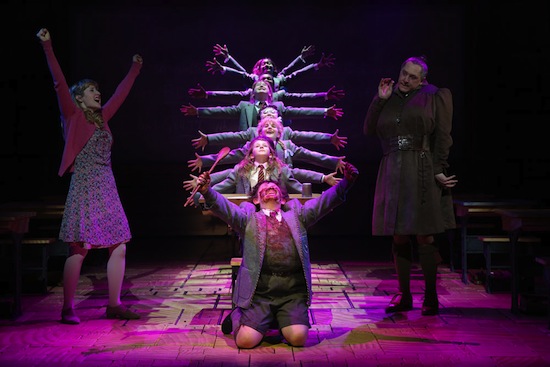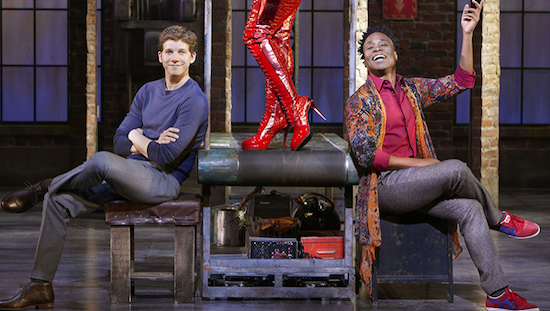If I ask myself what drew me to the theatre before I knew enough to even formulate the question, the answer has to be that it was a gigantic jolt to my emotions unlike any I had ever experienced. I was 15 years old and saw John Gielgud play the title role in Hamlet, a role he was famous for (although I did not know that at the time) in a play I had not read and knew nothing about.
It rocked my world.
If I were to say in one sentence what it is about the theatre that has caused this attraction to retain its pre-eminence with me through the years, it would be this: Theatre is life—incarnate, alive, on stage. It takes all of the other arts combined to create it, and when the stars align and the results are powerful, theatre holds that fabled mirror up to nature like nothing else.
It shows us who we are.
In great part, the power of a good play or musical is unmatched because it is alive and you share it with a roomful of other live bodies. And one more thing: You can’t fake it on stage. It has to be an honest piece of work. I’m not suggesting that there’s no room for variation within those parameters. Some things are intentionally off the wall, crazy or cartoonish. Anything is acceptable on stage if it’s skillful enough to be persuasive. Satire has and should have the leeway to be outrageous. But honesty can only encompass craziness and outrageousness as long as each is faithful to its intent.
To back track briefly: Years ago I wrote a piece suggesting that vulgarity in the theatre is always acceptable when it is an integral part of a character’s innate behavior or a scene’s emotional premise. It is offensive only when it is gratuitous.
The same formula applies to just about every aspect of theatrical invention, especially, as I was recently reminded, when it comes to the theatre’s newest comers: technical effects. These are increasingly used, increasingly magical and, no small thanks to the movies and video games (where they are frequently abused), we’ve developed an increasing appetite for them. But there’s still no room for cheating. Some effects enhance a production by being integral to it, and the rest merely adorn its flaws hoping to mask them.
My Broadway weekend reminded me of all of that once again. There is no substitute for that thing that moves you. Two shows I saw validated this point. The first is Matilda, based on the Roald Dahl children’s book of the same name; the second is Kinky Boots, based on a film that managed to miss much attention when it came out in 2005. The real surprise is that both have been resurrected as musicals. Good ones at that.
Both top the list of this year’s Tony® Award nominations and both illustrate how masterful our achievements in technical wizardry have become. Our hunger for it has not only grown, but we now tend to expect it. The chief problem lies in defining the purpose of all that power and light. It may be innately seductive, but it still needs a reason to exist. In theatre as in life, the genuine article trumps the merely showy one, but differences of degree are one thing and differences of intent quite another.
Our senses are so saturated with overkill of all sorts and these differences are often so subtle that it takes a contrast to show them up. As if on cue, Matilda and Kinky Boots, materializing in the same New York springtime, provide a pretty good one.
Two things become evident when you sit through a show: the degree of heat generated from the stage and, usually, the level of audience enthusiasm in response to it. (I say “usually” because I have at times sat unmoved in a theatre packed with wildly responsive other people; it happens, but not often.)
Tempo, timing, tension, fun, skill and humanity form the essentials of a really good show and Kinky Boots has those in abundance. With Matilda, perhaps because of its origins as a dark and cartoonish children’s book, the stage adaptation relies heavily on broadly sketched adult characters—caricatures as viewed through the eyes of a child in all cases but one—and while the talent of the actors is unquestionable, they are stuck with the dispassionate tone of the material. Meanwhile, a couple of other things strike imaginative but distracting notes: Rob Howell’s set, composed of children’s building blocks and floor-to-ceiling moveable shelves laden with books, emerges as more cumbersome than inspired—and Hugh Vanstone’s darting play with lights suggests a desperate Tinker Bell hoping to bridge the distance between stage and viewer with sheer agitation.
This enterprise comes off as an odd cross between Charles Dickens and Tim Burton, not only in the loping capers of the talented Bertie Carvel as Miss Trunchbull (a fascinatingly insecure relative of Annie’s Miss Hannigan), but in what I can only describe as the aura of the entire production. There is plenty of room for admiration, but not enough for a satisfying connection.
Kinky Boots, with its humbler origins, surprises in the opposite direction and is an interesting testament to the value of perseverance. From several accounts, all did not start off too well with this show in Chicago (where it was born). By the time it landed on Broadway a good deal of hard work must have gone into a lot of tweaking to produce the final result. While this result hardly shies away from technical effects, they are an exhilarating union of method and purpose.
It is doubtful that this season has to offer a more symbiotic example of dance and movement—choreographic engineering?—some of it performed on factory treadmills, as in the culminating number of act one. And costume designer Greg Barnes clearly had a field day delivering all of the enchantingly clever and/or gorgeous costumes, to say nothing of the titular footwear. (Watch the nation’s taste for absurdly kinky boots rise measurably in the wake of this show’s success.)
The point here is not to compare productions; every show or play is its own entity with vastly different aspirations that all need to be respected. The point is that seeing these two so close together merely illustrated once again the truth-or-consequences nature of the theatre.
So… The Tony Awards are coming right up. Confession: I do not take awards seriously. They are a deeply flawed, man-made, mostly mercantile affair—all the way up to the Pulitzers and the Nobels, let alone the Tonys.
In that silly of scheme things, the Tonys rank low on the award totem pole, if only because of the extreme narrowness of the field they cover: a handful of Manhattan’s city blocks. But, my feelings notwithstanding, performing arts awards do have a role to play, the chief one being a desire to reward artists who work extremely hard, night after night, for that fleeting round of applause. They richly deserve a moment in the sun. So on June 9, tune in and turn on (your television set) and watch those wonderful artists bask in it.
The Tony Awards will air on CBS on Sunday, June 9, at 8 pm ET.
Photos: Top, from Matilda; bottom, from Kinky Boots.


